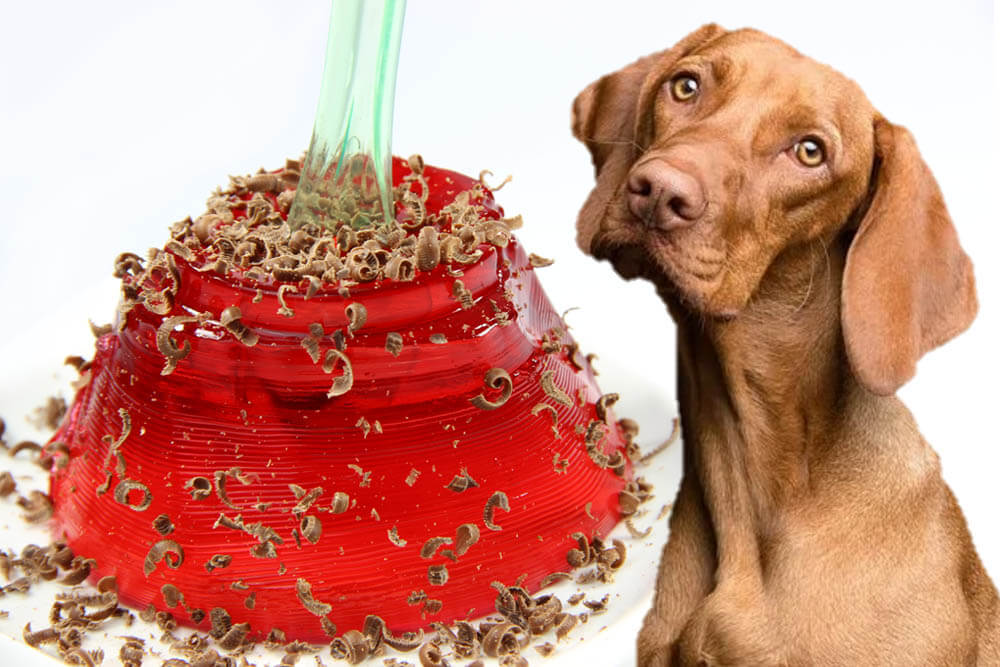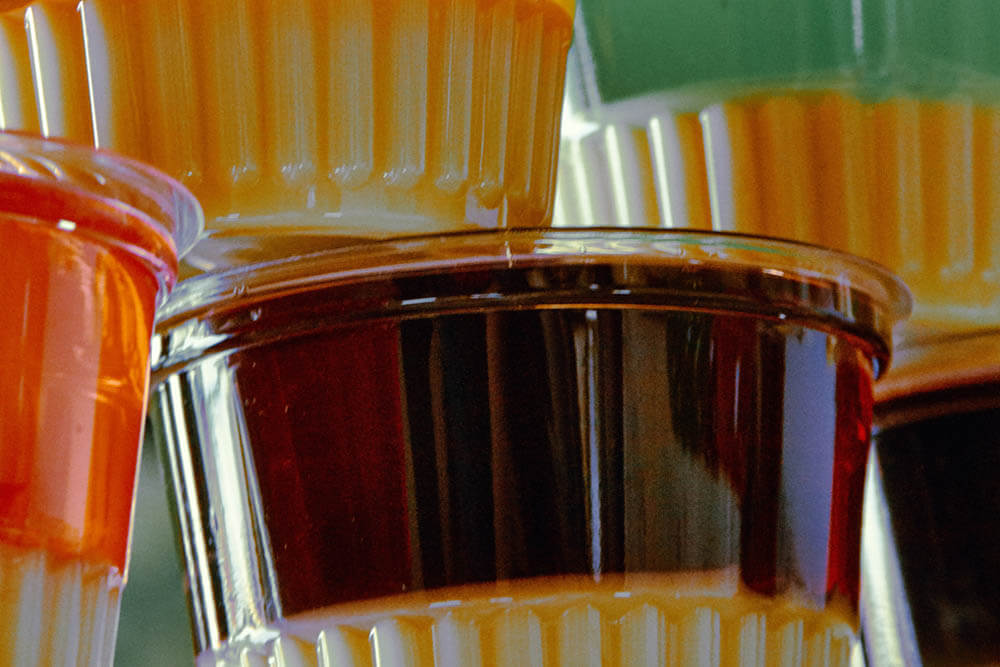Kraft Foods’ Jell-O dessert seems like the most harmless food you can give a dog.
Unfortunately, the opposite is true. Jell-O is high in sugar, which is never good for dogs. Worse, there are Jell-O varieties containing the artificial sweetener xylitol, which can cause deadly poisoning in canines.
So, in short, no, dogs can’t eat Jell-O.
Read on to know more about Jell-O and why it’s bad for dogs.

Xylitol: why Jell-O can kill your dog
Many groceries and supermarkets sell Jell-O variants that contain little to no sugar. These variants get their sweetness from a sugar substitute called xylitol.
Here’s the problem: xylitol is extremely toxic to dogs.
When a dog consumes Jell-O that’s been artificially sweetened using xylitol, their bloodstream absorbs the xylitol more rapidly than normal. This stimulates the pancreas to release insulin too quickly, which in turn causes the blood sugar levels to plummet, resulting in a condition known as hypoglycemia.
Untreated hypoglycemia can be deadly.
Xylitol ingestion produces the following symptoms:
- Vomiting
- Weakness
- Reduced activity
- Lack of coordination
- Staggering
- Seizures
- Collapse
Symptoms usually manifest between 10 and 60 minutes. However, it’s possible for a dog to experience no problems for as long as 24 hours. Therefore, dog owners should never assume a pet that’s eaten xylitol is safe just because they haven’t displayed any poisoning symptoms yet.
If your dog eats Jell-O containing xylitol, bring them to a vet clinic or animal hospital as early as possible for emergency treatment. Your dog may have to be hospitalized for additional treatment and monitoring.
Xylitol is found not only in sugar-free Jell-O but also in other foods and products, including:
- Chewing gum
- Baked goods
- Peanut butter
- Sugarless desserts
- Breath mints
- Toothpaste
- Mouthwash
- Chewable vitamins
- Cough syrup
- Over-the-counter drugs
- Dietary supplements
The prevalence of xylitol is among the chief reasons why pet parents should examine all food and product labels. Anything containing xylitol should be kept out of a dog’s sight and reach.

Sugar: why Jell-O is unhealthy for dogs
If xylitol-containing Jell-O is bad for dogs, why not just give them regular sugary Jell-O?
Sugar isn’t toxic to dogs. Many dogs can eat a few Jell-O shots without any issues.
Nevertheless, eating sugary foods isn’t good for dogs. And the more sugar they consume, the bigger the problems they can experience.
Gastrointestinal problems
Human-made sugar isn’t natural to dogs. As such, it can cause chaos in your dog’s digestive system, resulting in symptoms such as vomiting, diarrhea, gas, or a stomach ache. Even a single Jell-O shot can lead to such concerns.
Symptoms range in severity from mild to extreme. If your dog grows ill after eating Jell-O, contact a vet so they can tell you how to relieve your pet’s suffering.
Consuming a bit of Jell-O won’t make your dog fat. But frequent Jell-O consumption can lead to unhealthy weight gain and possibly even obesity.
Obesity increases the risk of:
- Heart disease
- Hypertension
- Diabetes mellitus
- Many cancers
- Osteoarthritis and faster joint degeneration
- Urinary bladder stones
- Heatstroke
These problems negatively impact a dog’s quality of life, health, and lifespan.
Your dog doesn’t even have to be obese to suffer from such issues. In a study involving Labrador Retrievers, researchers discovered being moderately overweight can shorten the canine life expectancy by almost two years.
Further complicating the issue is the fact that all those extra pounds reduce a dog’s mobility, making them less likely to participate in the exercise they need to lose weight.
Elevated blood sugar levels
Feeding your dog plenty of Jell-O can keep your dog’s blood sugar levels elevated, which can cause:
- Dehydration
- Extreme thirst
- Reduced energy levels
- Depression
- Seizures
- Coma
High blood sugar levels also increase the risk of heart disease, kidney disease, stroke, nerve problems, vision problems, and possibly even diabetes.
Pancreatitis
To bring elevated blood sugar levels back down to normal, a dog’s pancreas produces insulin, which breaks down sugar in the bloodstream.
Unfortunately, when dog owners feed dogs Jell-O in abundance, the pancreas is forced to work extra hard to keep up with the demand for more insulin. This can end up causing pancreatitis, which is when the pancreas gets damaged or inflamed.
The symptoms of pancreatitis include:
- Nausea
- Vomiting
- Diarrhea
- Abdominal pain
- Loss of appetite
- Lethargy
- Fever
- Pancreatitis “attack”
During an “attack,” a dog may stick their butt in the air and lower their head and forelegs to the ground. A severe attack can result in shock, depression, or even death.
Untreated pancreatitis can have lethal consequences.
Dental issues
The frequent consumption of sugary Jell-O raises the mouth’s acidity level, creating an environment conducive to tooth decay. Infected cavities can cause dogs great suffering. A dog could even lose teeth.
Sugar addiction
Sugary treats are addictive to dogs. A dog that develops an obsession with sugar-rich Jell-O can grow disinterested in healthy food, which can lead to their rejection of a nutritious, vet-approved diet. This can harm your dog’s health and leave them susceptible to illnesses and infections.
Lack of nutrients
The fact of the matter is Jell-O doesn’t have enough nutrients to justify feeding it to dogs. If you feed your pet Jell-O instead of healthier options, they’ll be missing out on nutrients such as vitamins, minerals, antioxidants, protein, and fiber, which are all necessary for every dog’s survival.

Keeping your dog healthy and safe
Whether or not your dog eats Jell-O, there are measures you can take to ensure they stay in good health.
Seek veterinary assistance
Let’s say your dog eats some Jell-O. What do you do?
First things first: check the food label to determine whether the ingested Jell-O contains sugar or xylitol.
If your dog ate a bit of sugar-rich Jell-O, don’t panic. As long as your dog doesn’t experience problems, then they’re likely fine. You can even give your dog Jell-O as an occasional treat – just know that, nutrition-wise, there are far more sensible treats your pooch can enjoy.
If your dog grows ill regardless of the amount of sugary Jell-O consumed, call a veterinarian for advice as soon as possible. A dog experiencing severe symptoms should be brought to a pet clinic or hospital.
A dog that ingests any amount of xylitol should be taken to the vet immediately. Removing the deadly toxin from their system requires emergency treatment by a professional. A poisoned canine will likely need to be hospitalized for additional treatment and observation.
If no vets are available during a crisis, those in North America can contact the Pet Poison Helpline at (855) 764-7661.
Hide your Jell-O
Store Jell-O and any other food that has lots of sugar in places your dog has no access to, such as the fridge or the kitchen cupboards. Do the same for foods and products containing xylitol.
Be especially careful if you have puppies, obese dogs, or diabetic dogs at home. Such dogs are more susceptible to developing problems upon ingesting foods high in sugar. Xylitol can kill a dog no matter their age, size, sex, and breed.
Be prepared for the worst
Familiarize yourself with the phone numbers and locations of your region’s best pet clinics and hospitals. Ensure these details are readily available by storing them on every family member’s phone and writing them down where they can be seen by all.
Keep a record of the aforementioned Pet Poison Hotline, too!

Gelatin: the healthy Jell-O alternative
If you want your dog to enjoy a jelly treat, a healthy alternative to Jell-O is plain, unflavored, unsweetened gelatin.
Gelatin is made by boiling the bones, ligaments, tendons, and/or skin of chickens, cows, or pigs in water. There’s even gelatin made from fish.
Thanks to its protein and amino acid content, gelatin helps keep a dog’s joints, skin, and hair healthy. Its anti-inflammatory properties allow it to treat osteoporosis and arthritis. It can also relieve an upset stomach and diarrhea.
In stores, gelatin is usually available in powder form. This powder can be mixed with other dog-friendly ingredients (such as plain chicken breast, carrots, and water) then cooled in the fridge to create jelly treats for your dog. There are plenty of online resources offering homemade gelatin recipes for pets.
Alternatively, you can simply sprinkle gelatin powder onto your dog’s wet food.
Dogs can also eat gelatin capsules. On the other hand, store-bought gelatin sweets such as gelatin gummies often contain sugar or toxic sugar substitutes, so stay away from them.
Gelatin brands that are great for dogs include Knox Gelatin and Great Lakes Gelatin.
Make sure the gelatin you give your pet contains no flavoring and no artificial sweetener such as xylitol.

Final thoughts…
As Jell-O contains either sugar or xylitol – both of which can harm your dog – it’s best to avoid giving your pet this jelly treat. If your dog becomes ill after eating Jell-O, don’t hesitate to contact a veterinarian.
Instead of Jell-O, try giving your dog gelatin, instead. Your pet will enjoy it and benefit from its protein content!
